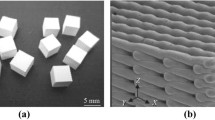Abstract
The direct metal lamination is a kind of the additive manufacturing process using the arc welding technology; where the molten metal made by the arc discharge is accumulated successively in this process. Overhanging shapes can be fabricated without support materials but lamination height error is caused in largely inclined area. In this paper, the lamination height error was estimated by using the accumulated metal shape model. Then, the lamination height error was compensated by changing welding torch feed speed so that the top surface of the laminated layer became horizontal. As a result, not only the lamination height error was decreased by 50%, but average inclination angle error was decreased by 50%.
Similar content being viewed by others
Abbreviations
- I :
-
Welding current
- V :
-
Welding voltage
- F :
-
Torch feed speed
- H :
-
Target lamination height per layer
- θ :
-
Inclination angle
- e :
-
Molten metal dropped point error
- a :
-
Coefficient of symmetric parabola which is approximated as the bead top surface profile
- H θ :
-
Lamination height which is actually required
- F θ :
-
Torch feed speed when inclination angle is θ
- R 2 :
-
Coefficient of determination
References
Kruth, J. P., Leu, M. C., and Nakagawa, T., “Progress in Additive Manufacturing and Rapid Prototyping,” CIRP Annals-Manufacturing Technology, Vol. 47, No. 2, pp. 525–540, 1998.
Wohlers Associates Inc., “Wohlers Report 2013,” pp. 23–31, 38–53, 2013.
Furumoto, T., Ueda, T., Alkahari, M. R., and Hosokawa, A., “Investigation of Laser Consolidation Process for Metal Powder by Two-Color Pyrometer and High-Speed Video Camera,” CIRP Annals-Manufacturing Technology, Vol. 62, No. 1, pp. 223–226, 2013.
Buchbinder, D., Schleifenbaum, H., Heidrich, S., Meiners, W., and Bültmann, J., “High Power Selective Laser Melting (HP SLM) of Aluminum Parts,” Physics Procedia, Vol. 12, pp. 271–278, 2011.
Kamioka, T., Abe, T., Ishikawa, S., and Sasahara, H., “Influence of the Cooling Method of the Molten Pool on the Laminating Characteristics in Direct Metal Lamination by Using Arc Discharge,” Transactions of the Japan Society of Mechanical Engineers Series C, Vol. 78, No. 5, pp. 282–291, 2012.
Abe, T. and Sasahara, H., “Residual Stress and Deformation after Finishing of a Shell Structure Fabricated by Direct Metal Lamination using Arc Discharge,” International Journal of Automation Technology, Vol. 6, No. 5, pp. 611–617, 2012.
Abe, T., Katagiri, M., and Sasahara, H., “Accurate Fabrication by Improvement of Lamination Path on Direct Metal Lamination using Arc Discharge,” Proc. of American Society for Precision Engineering, pp. 296–299, 2012.
Tanaka, K., Abe, T., Yoshimaru, R., and Sasahara, H., “Strength of Manufactured Object Made by Direct Metal Lamination Using Arc Discharge (in Japanese),” Transactions of the Japan Society of Mechanical Engineers Series C, Vol. 79, No. 800, pp. 1168–1178, 2013.
Suryakumar, S., Karunakaran, K., Bernard, A., Chandrasekhar, U., Raghavender, N., and Sharma, D., “Weld Bead Modeling and Process Optimization in Hybrid Layered Manufacturing,” Computer-Aided Design, Vol. 43, No. 4, pp. 331–344, 2011.
Song, Y. A., Park, S., and Chae, S. W., “3D Welding and Milling: Part II-Optimization of the 3D Welding Process using an Experimental Design Approach,” International Journal of Machine Tools and Manufacture, Vol. 45, No. 9, pp. 1063–1069, 2005.
Chatterjee, S. and Hadi, A. S., “Regression Analysis by Example,” John Wiley & Sons, pp. 43–46, 2012.
Author information
Authors and Affiliations
Corresponding author
Rights and permissions
About this article
Cite this article
Abe, T., Sasahara, H. Development of the shell structures fabrication CAM system for direct metal lamination using arc discharge-lamination height error compensation by torch feed speed control-. Int. J. Precis. Eng. Manuf. 16, 171–176 (2015). https://doi.org/10.1007/s12541-015-0022-4
Received:
Revised:
Accepted:
Published:
Issue Date:
DOI: https://doi.org/10.1007/s12541-015-0022-4




